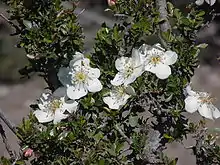Maleae
The Maleae (incorrectly Pyreae) are the apple tribe in the rose family, Rosaceae. The group includes a number of plants bearing commercially important fruits, such as apples and pears, while others are cultivated as ornamentals. Older taxonomies separated some of this group as tribe Crataegeae,[1][2] as the Cydonia group (a tentative placement),[2] or some genera were placed in family Quillajaceae.[2]
| Maleae | |
|---|---|
 | |
| Lindleya mespiloides in bloom | |
| Scientific classification | |
| Kingdom: | Plantae |
| Clade: | Tracheophytes |
| Clade: | Angiosperms |
| Clade: | Eudicots |
| Clade: | Rosids |
| Order: | Rosales |
| Family: | Rosaceae |
| Subfamily: | Amygdaloideae |
| Tribe: | Maleae Small 1933 |
| Subtribes | |
| |
| Synonyms | |
The tribe consists exclusively of shrubs and small trees. Most have pomes, a type of accessory fruit that does not occur in other Rosaceae. All except Vauquelinia (with 15 chromosomes) have a basal haploid chromosome count of 17, instead of 7, 8, or 9 as in the other Rosaceae.[3]
There are approximately 28 genera that contain about 1100 species worldwide, with most species occurring in the temperate Northern Hemisphere.
Nomenclature
The name Maleae is required by the International Code of Nomenclature for algae, fungi, and plants (article 19), for any group at the tribal level that includes the genus Malus, but not either of the genera Rosa or Amygdalus.[4]
Current classification
Core members of the group
A traditional circumscription of Maleae includes the following genera:[1][2][5][6]
- Amelanchier - serviceberry, juneberry
- Aria (see Sorbus)
- Aronia - chokeberry
- Chaenomeles - Japanese quince
- Chamaemeles
- Chamaemespilus (see Sorbus chamaemespilus)
- Cormus (see Sorbus)
- Cydonia - quince
- Dichotomanthes
- Docynia
- Docyniopsis
- Eriobotrya -loquat
- Eriolobus
- Hesperomeles
- Heteromeles - toyon
- Malacomeles
- Malus - apple, crabapple
- Osteomeles
- Peraphyllum
- Photinia
- Pseudocydonia - Chinese quince
- Pyrus - pear
- Rhaphiolepis - hawthorn
- Sorbus - rowan, whitebeam, service tree
- Stranvaesia
- Torminalis (see Sorbus torminalis)
- × Amelasorbus
- ×Malosorbus
- ×Sorbaronia
- × Sorbopyrus
and graft hybrids:
+Pyrocydonia (Pirocydonia)
Tribe Crataegeae
A recent taxonomic treatment includes the following genera in Maleae that were earlier separated as tribe Crataegeae (or as intertribe hybrids):[9]
- Cotoneaster - cotoneaster
- Crataegus - hawthorn
- Mespilus - medlar
- Pyracantha - firethorn
intergeneric (including intertribal) hybrids:[7]
- × Crataemespilus
- × Crataegosorbus
- × Sorbocotoneaster
and the graft hybrid:
Former members of family Quillajaceae
The following genera were previously placed in tribe Quillajaceae in Rosaceae, or in family Quillajaceae. Their fruit are dry capsules, not pomes.
The Cydonia group
The Cydonia group within the Maloid Rosaceae was a tentative grouping of pome-fruited genera with many ovules (rather than just two) per carpel.[2] The genera involved were:
It is not yet clear whether this group is monophyletic within the Maleae. Molecular data indicate a close relationship between Cydonia and Pseudocydonia.[6] Multiple ovules per carpel also occur in Kageneckia, a non-pome-bearing genus.[6] Chloroplast DNA analysis, but not nuclear DNA, shows a tight relationship between Cydonia and Dichotomanthes, a non-pome-bearing genus.[6]
References
| Wikimedia Commons has media related to Maleae. |
- G. K. Schulze-Menz 1964. Reihe Rosales. in A. Engler's Syllabus der Pflanzenfamilien mit besonderer Berücksichtigung der Nutzpflanzen nebst einer Übersicht über die Florenreiche und Florengebiete der Erde, Gebrüder Borntraeger, Berlin
- Kalkman, C. (2004). "Rosaceae". In K. Kubitzki (ed.). Flowering plants, dicotyledons : Celastrales, Oxalidales, Rosales, Cornales, Ericales. 6. Berlin: Springer. pp. 343–386.
- Goldblatt, P. (1976). "Cytotaxonomic studies in the tribe Quillajeae (Rosaceae)". Annals of the Missouri Botanical Garden. 63 (1): 200–206. doi:10.2307/2395226. JSTOR 2395226.
- McNeill, J.; Barrie, F.R.; Buck, W.R.; Demoulin, V.; Greuter, W.; Hawksworth, D.L.; Herendeen, P.S.; Knapp, S.; Marhold, K.; Prado, J.; Prud'homme Van Reine, W.F.; Smith, G.F.; Wiersema, J.H.; Turland, N.J. (2012), International Code of Nomenclature for algae, fungi, and plants (Melbourne Code) adopted by the Eighteenth International Botanical Congress Melbourne, Australia, July 2011, Regnum Vegetabile 154, A.R.G. Gantner Verlag KG, ISBN 978-3-87429-425-6 Article 19.
- Sterling, C. (1965). "Comparative morphology of the carpel in the Rosaceae. V. Pomoideae: Amelanchier, Aronia, Malacomeles, Malus, Peraphyllum, Pyrus, Sorbus". American Journal of Botany. 52 (4): 418–426. doi:10.2307/2440337. JSTOR 2440337.
- Campbell, C.S.; Evans, R.C.; Morgan, D.R.; Dickinson, T.A.; Arsenault, M.P. (2007). "Phylogeny of subtribe Pyrinae (formerly the Maloideae, Rosaceae): Limited resolution of a complex evolutionary history". Plant Systematics and Evolution. 266 (1–2): 119–145. doi:10.1007/s00606-007-0545-y.
- Stace, C. A. 1975. Hybridization and the flora of the British Isles. Academic Press, London.
- "USDA PLANTS".
- Potter, D.; Eriksson, T.; Evans, R.C.; Oh, S.H.; Smedmark, J.E.E.; Morgan, D.R.; Kerr, M.; Robertson, K.R.; Arsenault, M.P.; Dickinson, T.A.; Campbell, C.S. (2007). Phylogeny and classification of Rosaceae. Plant Systematics and Evolution. 266(1–2): 5–43. doi:10.1007/s00606-007-0539-9